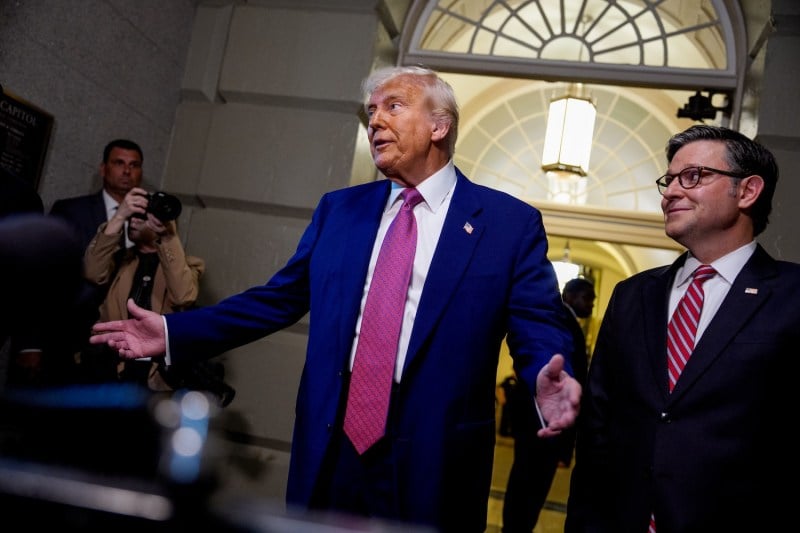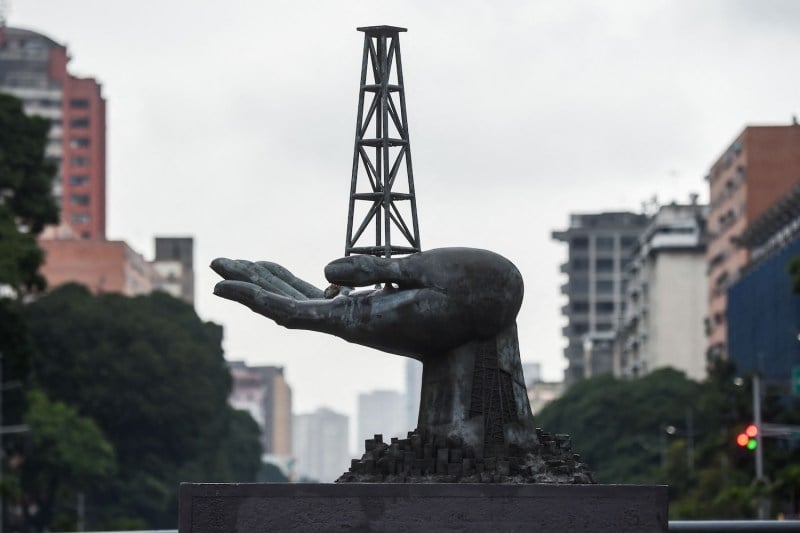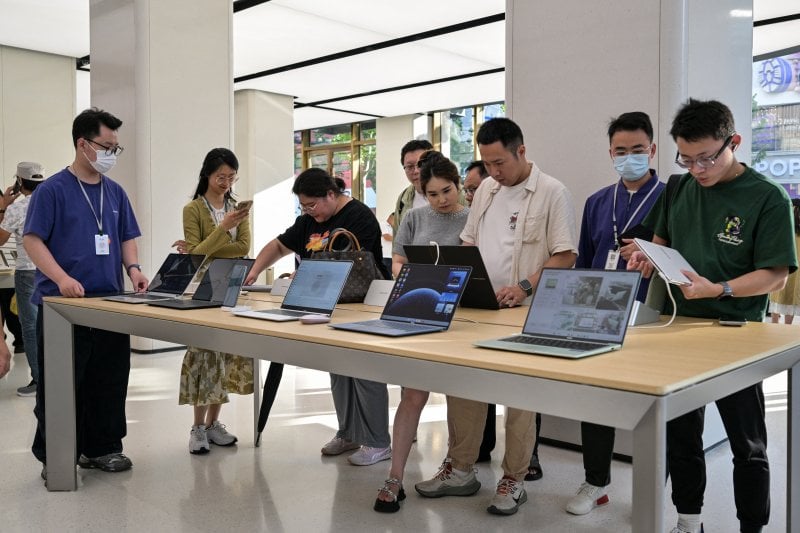Trump’s Trade Deals Are Missing in Action

Trump’s Trade Deals Are Missing in Action
Halfway through the 90-day tariff pause, almost no progress has been made to avoid global trade carnage.
U.S. President Donald Trump, accompanied by House Speaker Mike Johnson, talks to the media in Washington on May 20. Andrew Harnik/Getty Images
At just about the halfway point of the Trump administration’s self-imposed 90-day sprint to reach trade agreements with more than half the countries on Earth, the progress is dire, and the prospects look even worse.
Case in point: On May 23, just as U.S. and European trade negotiators are set to return to the table and sort out a raft of contentious issues, U.S. President Donald Trump did another about-face and threatened 50 percent tariffs on Europe starting next week if the world’s biggest economic bloc doesn’t yield to his dictates, which it hasn’t yet. He also threatened Apple with 25 percent tariffs on its iPhones if the company doesn’t move manufacturing of the product to the United States. Trump previously demanded that Apple shift production away from China, which it is now doing—but it’s moving that production to India, rather than Indiana.
At just about the halfway point of the Trump administration’s self-imposed 90-day sprint to reach trade agreements with more than half the countries on Earth, the progress is dire, and the prospects look even worse.
Case in point: On May 23, just as U.S. and European trade negotiators are set to return to the table and sort out a raft of contentious issues, U.S. President Donald Trump did another about-face and threatened 50 percent tariffs on Europe starting next week if the world’s biggest economic bloc doesn’t yield to his dictates, which it hasn’t yet. He also threatened Apple with 25 percent tariffs on its iPhones if the company doesn’t move manufacturing of the product to the United States. Trump previously demanded that Apple shift production away from China, which it is now doing—but it’s moving that production to India, rather than Indiana.
July 8 is the deadline that Trump set for negotiated trade concessions to avoid the arbitrary and sky-high tariffs that he announced in early April, the so-called “liberation day” tariffs that terrified markets and made him temporarily recalibrate. So far, only one has reached an agreement to pacify the Trump administration: the United Kingdom, which signed a small-scale, preemptive truce that will affect a handful of sectors such as fancy cars, jet engines, beef, and ethanol. The United States’ biggest and most important trade partners, including Canada, Mexico, China, the European Union, Japan, and South Korea, are still trying to find a formula to mollify the administration.
“Trump administration officials have been touting the number and significance of the coming trade deals, but so far there is just one announced deal (with the U.K.), which has not even taken effect yet,” said Simon Lester, an international trade lawyer who has been especially diligent in tracking the administration’s progress and transparency on trade talks.
“Maybe they can go on a 4th-quarter run that gets them back in the game, but at halftime it seems like a new strategy might be in order,” he said.
Talks with the EU are exhibit A for the dysfunction, and not just because Trump’s latest tariff threat more than doubles the rate of import duties he threatened on Europe in April. So far, the EU has offered up a cocktail of tried-and-true measures to appease Trump, from buying more U.S. energy (Europe could use a little more U.S. natural gas, but not that much) to strategic cooperation in sectors such as semiconductors, steel, and autos. The latest olive branch was coupled with an offer for zero-for-zero tariffs, meaning that both economic blocs would lower their primary trade barriers.
The U.S. response to Europe’s overture was reportedly one-sided: Europe must slash its tariffs and disembowel its entire regulatory and safety structure, while U.S. tariffs stay in place. Given that the problem, in Trump’s eyes, is that Europe sells more stuff to the United States than it buys, Brussels must budge, but Washington won’t. The progress and prospect of those talks can be measured in Friday’s dramatic threat to put higher tariffs on Europe than those currently on China.
But it’s not just Europe. Deals with almost every other major trading partner are also stumbling down the staircase. India, under Trump-friendly Prime Minister Narendra Modi, may be the closest to the finish line, but hurdles remain. Trump said India offered to remove all tariffs, which India denied. But India has a three-phase plan to calm Trump first, to avoid the immediate threat, and then move to substantive issues.
Other big U.S. trading partners are less blessed with political overlap between Trump and their leaders and have less margin to appease him. Japan and South Korea, both critical U.S. security allies in the Asia-Pacific, are struggling with slowing economies, as their export-heavy economies linger under a tariff shadow. And yet both are reluctant to surrender. South Korea, which has an existing free-trade agreement with the United States, logically wants tariffs to be lifted. Japan, too, wants zero tariffs, though it has no such free-trade agreement. Both countries also have elections on the horizon.
Canada and Mexico, the United States’ two biggest trading partners, have not made any substantive progress in securing fresh trade deals, either.
They, along with everyone other than the U.K., are a reminder that some of Trump’s punitive tariffs remain in place, despite the 90-day truce: There are sectoral import duties on steel, aluminum, and cars—and perhaps soon on pharmaceuticals, copper, and lumber.
The markets took ill to Trump’s April foray into trade policy, sending stock returns down and bond yields up, before calming back down on the apparent belief that things would return to normal. The vigilantes, though, are back. Equity indices such as the S&P 500 are wavering between hope and despair, while bond markets build bunkers. The absolute gold standard, safe-haven investment—long-term U.S. Treasury bills—is offering fire sales to attract buyers.
That is a verdict more eloquent than any European or Japanese trade negotiator could ever give.
This post is part of FP’s ongoing coverage of the Trump administration. Follow along here.
Keith Johnson is a reporter at Foreign Policy covering geoeconomics and energy. X: @KFJ_FP
Stories Readers Liked
In Case You Missed It
A selection of paywall-free articles

Four Explanatory Models for Trump’s Chaos
It’s clear that the second Trump administration is aiming for change—not inertia—in U.S. foreign policy.























Join the Conversation
Commenting is a benefit of a Foreign Policy subscription.
Subscribe
Subscribe
Already a subscriber?
.
View Comments
Join the Conversation
Join the conversation on this and other recent Foreign Policy articles when you subscribe now.
Subscribe
Subscribe
Not your account?
View Comments
Join the Conversation
Please follow our comment guidelines, stay on topic, and be civil, courteous, and respectful of others’ beliefs.
View Comments
Change your username |
Log out
Change your username:
CANCEL
Confirm your username to get started.
The default username below has been generated using the first name and last initial on your FP subscriber account. Usernames may be updated at any time and must not contain inappropriate or offensive language.